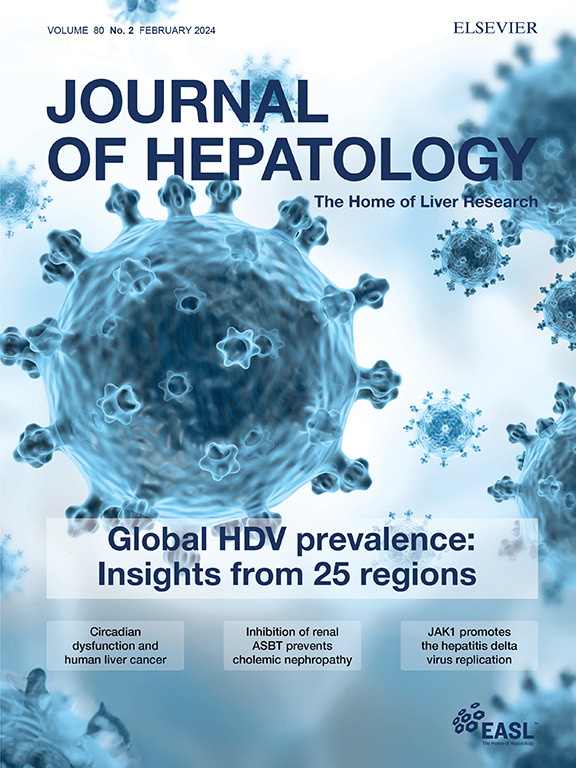CIDEB的体细胞功能丧失突变通过增加脂肪分解和脂肪酸氧化来减少肝脏脂肪变性
IF 26.8
1区 医学
Q1 GASTROENTEROLOGY & HEPATOLOGY
引用次数: 0
摘要
背景,目的体细胞和种系CIDEB突变与慢性肝病的保护有关。其机制基础和抑制CIDEB是否能有效治疗脂肪肝仍不清楚。方法将21个CIDEB体细胞突变导入细胞,评估其功能。通过体内筛选,在正常食物、western (WD)和缺乏胆碱、l -氨基酸限定的高脂肪(CDA-HFD)饮食的小鼠中追踪ciddeb突变克隆。通过构建和条件敲除Cideb小鼠来研究Cideb在肝脏疾病中的作用。同位素示踪用于评价脂肪酸氧化和新生脂肪生成。转录组学、脂质组学和代谢分析被用于探索分子机制。双敲除模型(Cideb/Atgl和Cideb/Pparα)测试了Cideb丢失的机制。结果大多数CIDEB突变显示它们损害功能,谱系追踪显示CDA-HFD阳性选择功能丧失克隆,但并非所有脂肪肝诱导饮食。Cideb KO小鼠不受WD、CDA-HFD和酒精饮食的影响,但对CDA-HFD诱导的肝脏疾病影响最大。肝细胞特异性Cideb缺失可以改善代谢功能障碍相关脂肪变性肝病(MASLD)建立后的疾病,模拟治疗性sirna的影响。柠檬酸损失通过增加β-氧化,特别是通过ATGL和PPARα活化来保护肝脏。结论scideb缺失对某些类型的脂肪肝有保护作用。β-氧化是Cideb保护机制的重要组成部分。抑制CIDEB是一种很有前途的方法,CIDEB的体细胞突变可以预测可能受益最大的患者群体。影响和意义目前尚不清楚为什么体细胞和种系CIDEB突变对MASLD具有保护作用。Cideb突变主要是功能丧失,并且Cideb缺陷克隆在特定饮食环境下选择性扩增,例如cda - hfd诱导的MASLD。与此一致的是,CDA-HFD饲喂后,全肝脏Cideb的缺失对MASLD的改善最为深刻。从机制上讲,苹果酸缺乏通过ATGL和PPARα活化促进肝脏脂肪酸β-氧化。这些发现表明,CIDEB抑制可能在促进CIDEB突变克隆扩增的MASLD亚型患者中最有效。本文章由计算机程序翻译,如有差异,请以英文原文为准。

Somatic loss-of-function mutations in CIDEB reduce hepatic steatosis by increasing lipolysis and fatty acid oxidation
Background & Aims
Somatic and germline CIDEB mutations are associated with protection from chronic liver diseases. The mechanistic basis and whether CIDEB suppression would be an effective therapy against fatty liver disease remain unclear.Methods
21 CIDEB somatic mutations were introduced into cells to assess functionality. In vivo screening was used to trace Cideb mutant clones in mice fed normal chow, western (WD), and choline-deficient, L-amino acid-defined, high-fat (CDA-HFD) diets. Constitutive and conditional Cideb knockout mice were generated to study Cideb in liver disease. Isotope tracing was used to evaluate fatty acid oxidation and de novo lipogenesis. Transcriptomics, lipidomics, and metabolic analyses were utilized to explore molecular mechanisms. Double knockout models (Cideb/Atgl and Cideb/Pparα) tested mechanisms underlying Cideb loss.Results
Most CIDEB mutations showed that they impair function, and lineage-tracing showed that loss-of-function clones were positively selected with CDA-HFD, but not all fatty liver inducing diets. Cideb KO mice were protected from WD, CDA-HFD, and alcohol diets, but had the greatest impact on CDA-HFD induced liver disease. Hepatocyte-specific Cideb deletion could ameliorate disease after metabolic dysfunction-associated steatotic liver disease (MASLD) establishment, modeling the impact of therapeutic siRNAs. Cideb loss protected livers via increased β-oxidation, specifically through ATGL and PPARα activation.Conclusions
Cideb deletion is more protective in some types of fatty liver disease. β-oxidation is an important component of the Cideb protective mechanism. CIDEB inhibition represents a promising approach, and somatic mutations in CIDEB might predict the patient populations that might benefit the most.Impact and Implications
It is not clear why somatic and germline CIDEB mutations are protective in MASLD. Cideb mutations are predominantly loss of function, and Cideb-deficient clones selectively expand in specific dietary contexts such as CDA-HFD-induced MASLD. Consistently, liver-wide deletion of Cideb ameliorates MASLD most profoundly after CDA-HFD feeding. Mechanistically, Cideb deficiency enhances hepatic fatty acid β-oxidation via ATGL and PPARα activation. These findings suggest that CIDEB inhibition might be most effective in patients with the subtypes of MASLD that promote the expansion of CIDEB mutant clones.求助全文
通过发布文献求助,成功后即可免费获取论文全文。
去求助
来源期刊

Journal of Hepatology
医学-胃肠肝病学
CiteScore
46.10
自引率
4.30%
发文量
2325
审稿时长
30 days
期刊介绍:
The Journal of Hepatology is the official publication of the European Association for the Study of the Liver (EASL). It is dedicated to presenting clinical and basic research in the field of hepatology through original papers, reviews, case reports, and letters to the Editor. The Journal is published in English and may consider supplements that pass an editorial review.
 求助内容:
求助内容: 应助结果提醒方式:
应助结果提醒方式:


